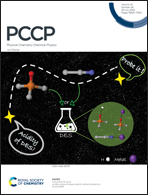Strain induced magnetic hysteresis in MoS2 and WS2 monolayers with symmetric double sulfur vacancy defects†
Abstract
It has been found that magnetism in two-dimensional (2D) transition metal dichalcogenides can be realized by properly introducing vacancies and applying strain. However, no work has clearly clarified the modulation of such 2D magnetism under a sweeping strain. Thus we were motivated in this work to investigate the mechanical and electronic properties of the monolayer MS2 (M = Mo, W) with symmetric S vacancy defects under sweeping strain. The results show that the local structure of the M atoms in MS2 around the defect undergoes a reversible phase transition from a triangular shape (Tri-3M) with short M–M bonds, to a circular one (Cir-6M-12S) with larger M–M bonds as the planar strain increases. The critical tensile strain for the transition from Tri-3M to Cir-6M-12S are 12.53% for MoS2 and 11.46% for WS2, while the critical compressive strain for the reversal from Cir-6M-12S to Tri-3M are −3.60% and −2.16%, respectively. In particular, we find that the magnetism can be continuously modulated and undergoes a hysteresis loop behavior under the sweeping strains, with the residual magnetism being 2 μB. Our work theoretically predicts the promising prospect for exploring low-dimensional semiconductor spintronic devices working without applying a magnetic field.



 Please wait while we load your content...
Please wait while we load your content...